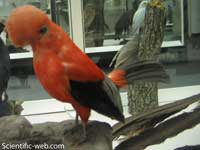The Andean Cock-of-the-rock (Rupicola peruvianus)[1][2] is a medium-sized passerine bird of the Cotinga family native to Andean cloud forests in South America. The plural is Andean Cocks-of-the rock. It is widely regarded as the national bird of Peru.[3][4] The species exhibits marked sexual dimorphism; the male has a large disk-like crest and scarlet or brilliant orange plumage, while the female is significantly darker and browner. Gatherings of males compete for breeding females with each male displaying its colourful plumage, bobbing and hopping, and making a variety of calls. After mating, the female makes a nest under a rocky overhang, incubates the eggs, and rears the young, all by herself. Taxonomy One of two species in the genus Rupicola, the Andean Cock-of-the-rock was first described by English ornithologist John Latham in 1790. The generic name is derived from the Latin stems rupes "rock" or "cliff", and cola "inhabiting",[5] and is derived from its habit of nesting in rock walls. Its specific epithet peruvianus "of Peru" is masculine despite the -a ending of the genus name (in Latin, names in -cola were masculine or neuter); peruviana is seen in older works.[1] Four subspecies are known:[6] * R. p. peruvianus, (Latham) 1790 - nominate subspecies Description The Andean Cock-of-the-rock is a medium-sized, approximately 32 cm (12½ in) long, passerine which exhibits marked sexual dimorphism. The male has a large disk-like crest and scarlet or brilliant orange plumage. It has black tail and wings, and pale grey scapulars. The female is significantly darker and browner than the male and has a shorter crest. The bill is yellowish in the male, and dark with a small yellow tip in the female. Depending on gender and subspecies there are significant variations in the colour of the iris, ranging from red over orange and yellow to bluish-white in the male, and whitish over reddish to brown in the female.[4] In addition to the display calls described in the breeding section below, foraging birds give a loud querulous "uankk?" when disturbed or in flight.[7] Distribution and habitat The Andean Cock-of-the-rock is distributed in cloud forests of the Andes in a large range of about 260,000 km² across Venezuela, Colombia, Ecuador, Peru, and Bolivia,[8] mostly in ravines and forested streams in montane areas at 500–2400 meters elevation. It typically stays in the lower and middle forest levels, but will range higher in fruiting trees and sometimes will enter and cross clearings. It is generally shy and inconspicuous, often seen only briefly after being flushed or swiftly flying down a valley.[7] Behaviour Food and feeding The diet consists mainly of fruit and insects, although small vertebrates such as frogs or lizards have been recorded.[9] They are one of many species recorded following army ants.[10] Breeding The male takes the lesser part in breeding, is polygamous, and has nothing to do with nesting once mating is done. The male's energy instead is devoted to very elaborate display rituals that show off its magnificent plumage. These displays take place in communal leks, where males gather to challenge rivals and beckon the females.[4] The males are easily disturbed, so their behavior is not easy to see.[7] One study reported that the display activity is dependent on light intensity, with the morning display period occurring during the same light intensity level as the afternoon period.[11] At the lek males have been observed to break up into pairs, performing "confrontation displays". This consists of facing each other while bowing, jumping, and flapping their wings, sometimes even snapping their bills, and at the same time giving off various squawking and grunting calls. When the female approaches, it becomes even more intense. The display turns into a cacophony of bright color and frenzied activity filled with very strange sounds.[7] Nesting The nests, built entirely by the female, are mud plastered to cave entrances or rocky outcrops in forest ravines.[12] The female typically lays two white eggs.[13] Status The worldwide population size and trends in population numbers have not been determined, but is it believed that the Andean Cock-of-the-rock is not threatened and so the species is evaluated as Least Concern on the IUCN Red List of Threatened Species.[8] References 1. ^ a b David, N., & Gosselin, M. (2002). The grammatical gender of avian genera. Bulletin of the British Ornithologists' Club. 122(4): 257-282. External links
|
|

